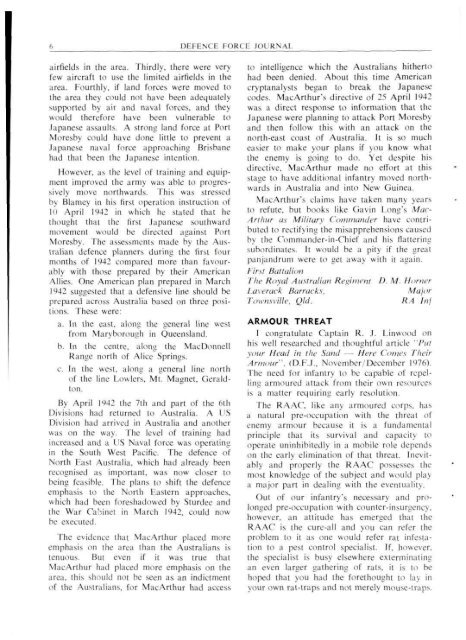ISSUE 3 : Mar/Apr - 1977 - Australian Defence Force Journal
ISSUE 3 : Mar/Apr - 1977 - Australian Defence Force Journal
ISSUE 3 : Mar/Apr - 1977 - Australian Defence Force Journal
Create successful ePaper yourself
Turn your PDF publications into a flip-book with our unique Google optimized e-Paper software.
6 DEFENCE FORCE JOURNALairfields in the area. Thirdly, there were veryfew aircraft to use the limited airfields in thearea. Fourthly, if land forces were moved tothe area they could not have been adequatelysupported by air and naval forces, and theywould therefore have been vulnerable toJapanese assaults. A strong land force at PortMoresby could have done little to prevent aJapanese naval force approaching Brisbanehad that been the Japanese intention.However, as the level of training and equipmentimproved the army was able to progressivelymove northwards. This was stressedby Blarney in his first operation instruction of10 <strong>Apr</strong>il 1942 in which he stated that hethought that the first Japanese southwardmovement would be directed against PortMoresby. The assessments made by the <strong>Australian</strong>defence planners during the first fourmonths of 1942 compared more than favourablywith those prepared by their AmericanAllies. One American plan prepared in <strong>Mar</strong>ch1942 suggested that a defensive line should beprepared across Australia based on three positions.These were:a. In the east, along the general line westfrom <strong>Mar</strong>yborough in Queensland.b. In the centre, along the MacDonnellRange north of Alice Springs.c. In the west, along a general line northof the line Lowlers, Mt. Magnet, Geraldton.By <strong>Apr</strong>il 1942 the 7th and part of the 6thDivisions had returned to Australia. A USDivision had arrived in Australia and anotherwas on the way. The level of training hadincreased and a US Naval force was operatingin the South West Pacific. The defence ofNorth East Australia, which had already beenrecognised as important, was now closer tobeing feasible. The plans to shift the defenceemphasis to the North Eastern approaches,which had been foreshadowed by Sturdee andthe War Cabinet in <strong>Mar</strong>ch 1942. could nowbe executed.The evidence that MacArthur placed moreemphasis on the area than the <strong>Australian</strong>s istenuous. But even if it was true thatMacArthur had placed more emphasis on thearea, this should not be seen as an indictmentof the <strong>Australian</strong>s, for MacArthur had accessto intelligence which the <strong>Australian</strong>s hithertohad been denied. About this time Americancryptanalysts began to break the Japanesecodes. MacArthur's directive of 25 <strong>Apr</strong>il 1942was a direct response to information that theJapanese were planning to attack Port Moresbyand then follow this with an attack on thenorth-east coast of Australia. It is so mucheasier to make your plans if you know whatthe enemy is going to do. Vet despite hisdirective, MacArthur made no effort at thisstage to have additional infantry moved northwardsin Australia and into New Guinea.MacArthur's claims have taken many yearsto refute, but books like Gavin Long's Mac-Artluir as Military Commander have contributedto rectifying the misapprehensions causedby the Commander-in-Chief and his flatteringsubordinates. It would be a pity if the greatpanjandrum were to get away with it again.First BattalionThe Royal <strong>Australian</strong> Regiment D. M. HornerLaverack Barracks,MajorTownsvUle, QUI.RA In!ARMOUR THREATI congratulate Captain R. J. Linwood onhis well researched and thoughtful article "Putyour Head in the Sand — Here Comes TheirArmour". (D.F.J., November/December 1976).The need for infantry to be capable of repellingarmoured attack from their own resourcesis a matter requiring early resolution.The RAAC, like any armoured corps, hasa natural preoccupation with the threat ofenemy armour because it is a fundamentalprinciple that its survival and capacity tooperate uninhibitedly in a mobile role dependson the early elimination of that threat. Inevitablyand properly the RAAC possesses themost knowledge of the subject and would playa major part in dealing with the eventuality.Out of our infantry's necessary and prolongedpre-occupation with counter-insurgency,however, an attitude has emerged that theRAAC is the cure-all and you can refer theproblem to it as one would refer rat infestationto a pest control specialist. If, however,the specialist is busy elsewhere exterminatingan even larger gathering of rats, it is to behoped that you had the forethought to lay inyour own rat-traps and not merely mouse-traps.
















